Opinion
The new One UI 4.0 Quick Settings on Samsung smartphones was really required: Opinion
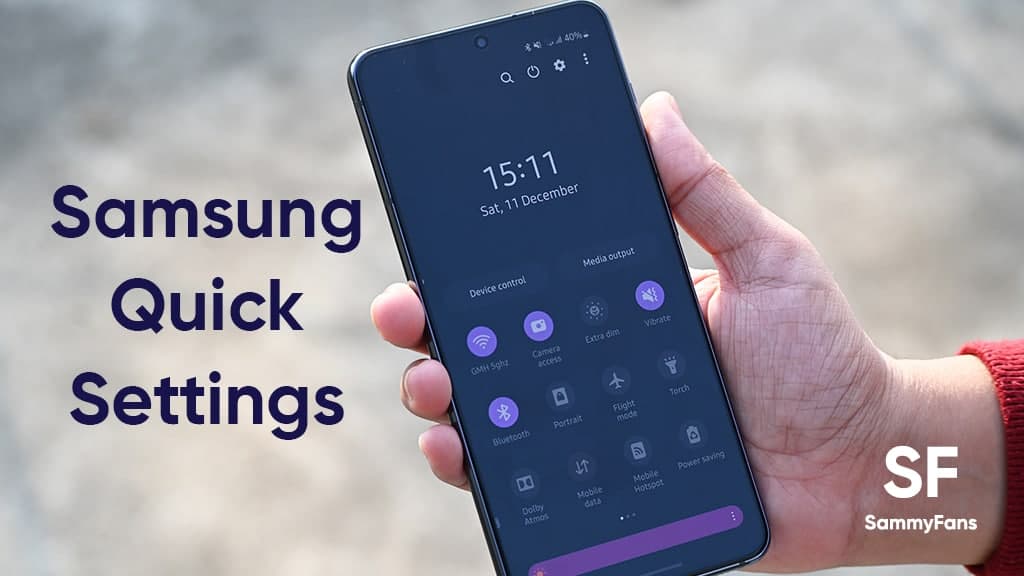
Samsung smartphones have a variety of different software features but Quick Settings is a place that comes first to our reach and has almost every possible and required solution that is quick and easy to access. However, the One UI 4.0 has brought in some of the least possible changes that were really required.
How? Let’s find out.
As a Samsung smartphone owner, the One UI software ecosystem has been quite a unique and refreshing user experience for me. The core is powered by Android and the latest Android 12 has further helped One UI 4.0 to achieve its maximum capability.
Talking about the quick Settings, the One UI 4.0 brings a number of new additions to switches, color palette, better visibility, and background color. These changes were required in terms of maximizing the user experience.
Let’s explore.
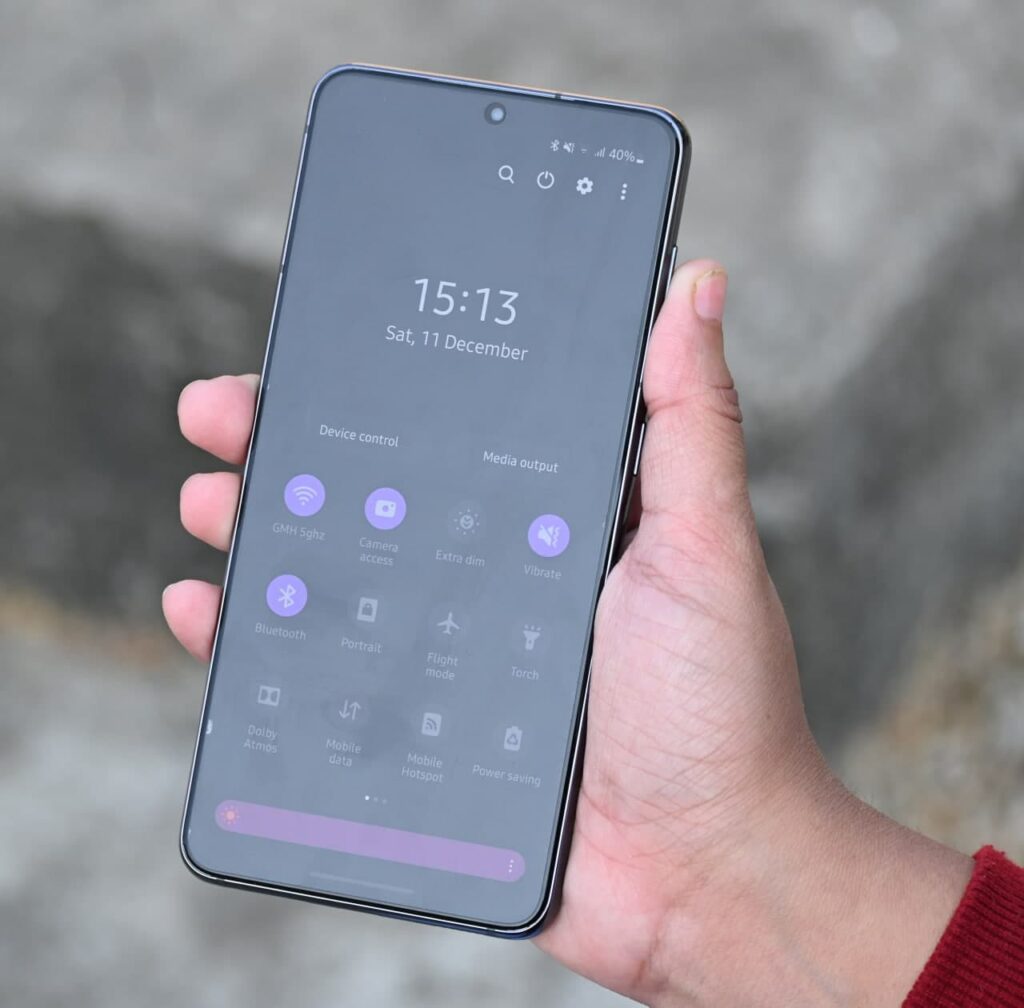
Icons:
The quick settings icons on Samsung smartphones are the access switch for different kinds of features, which you can enable or disable with just a tap of your finger. The latest change in this section utilizes customization and makes the icons more lightweight and subtle.
The overall appearance of the quick access switch is cleaner and elegant. The icons are now also better than the past version One UI.
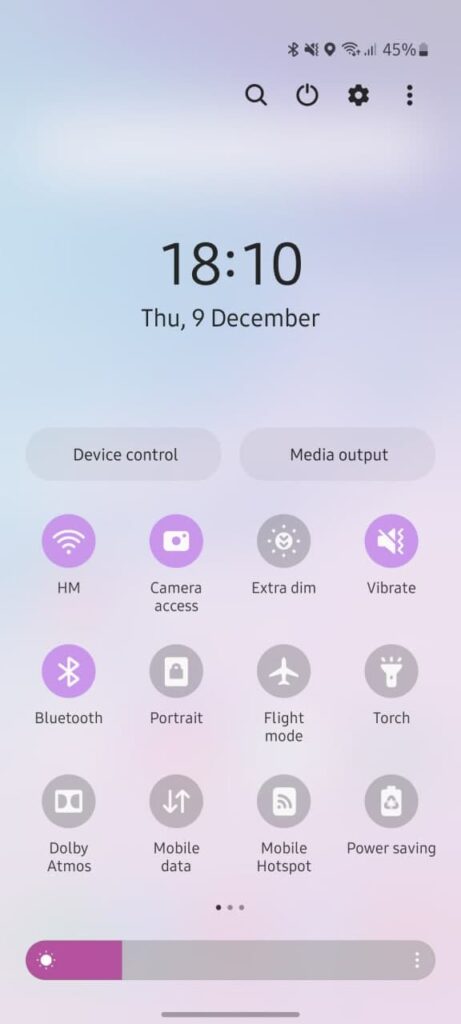
Color Palette:
The latest Android 12 brings Material You design that helps you to get your phone know your suitable color scheme. In One UI 4.0, you can choose the color of quick access switches based on the colors generated from your phone’s current wallpaper.
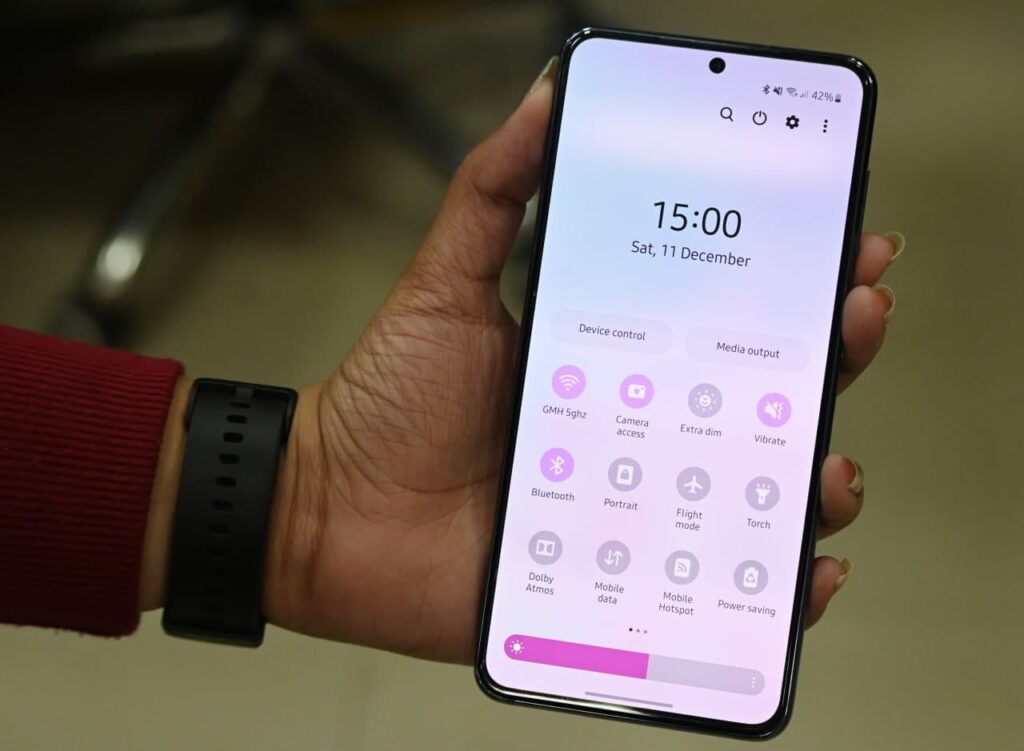
Font:
The new font-weight used for time and date really leads you towards the maximum viewable spot and focuses your eyes towards the area for the above-mentioned labels. A similar change has also been made for the text below quick access switches.
Background:
One UI 4.0 is enhanced for better use cases and Samsung has removed some of the most know visibility issues that have been oddly available on One UI 3.1. This is due to the translucent background that is now a bit more solid while providing you with a perfect sync between color and quick settings.
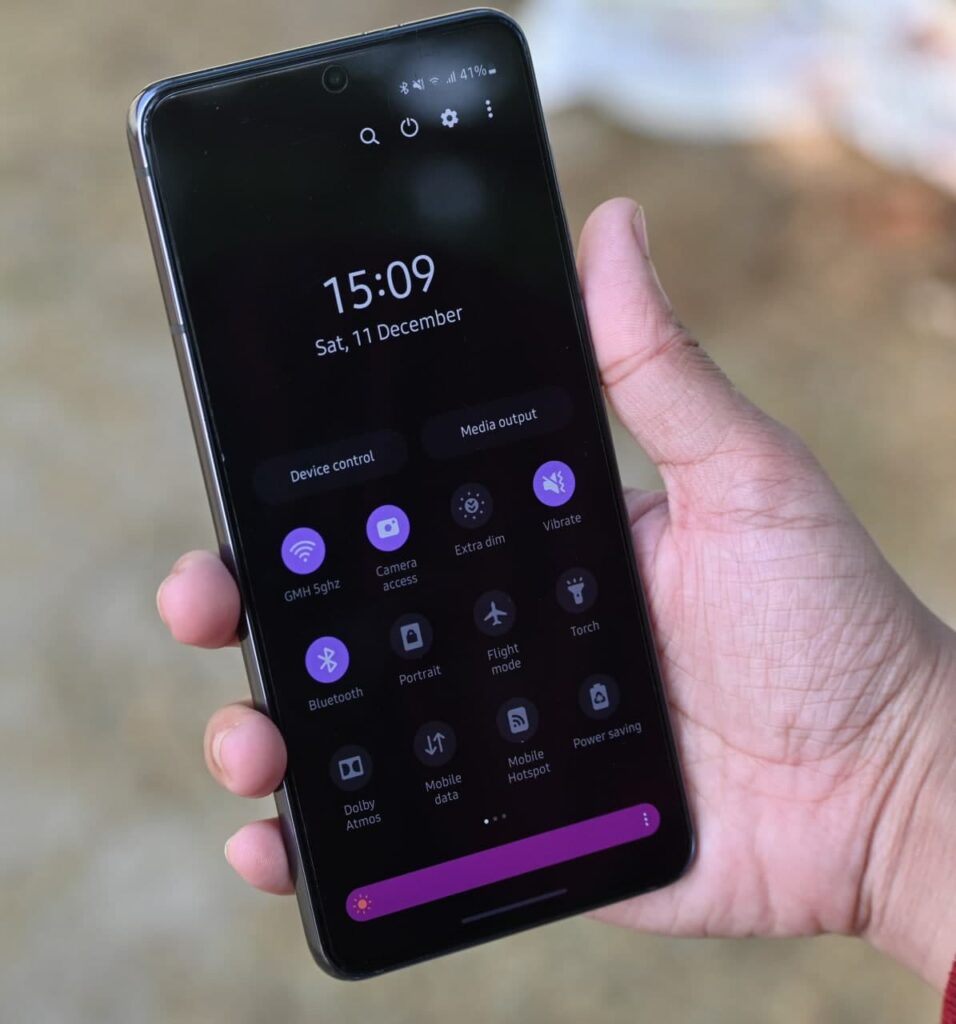
Sliders:
Yes! The brightness controller on the bottom has now been refinished and given a brand new look with its new Horizontal slider that is materialistic.

Visibility:
Visibility has been a major area of improvement on the One UI 4.0 Quick Settings panel that works very well in indoor and outdoor conditions. So, you can expect good viewing angles and untangle information on your One UI 4.0 powered Samsung smartphone, while looking at your Quick Settings.

Opinion
Google advances to Android 16, Samsung delays decision on One UI 7

Google has just released the first Developer Preview of Android 16, hinting at an earlier rollout compared to what we’ve seen before. Google is pushing this update to ensure that device manufacturers can adopt it quickly.
While Google is moving ahead with Android 16, Samsung appears to be taking its time with the One UI interface. Typically, Samsung rolls out One UI updates together with Google’s Android releases, but Android 15-based One UI 7.0 is yet to reach the beta stage.
It looks like Samsung is still working with One UI 7 internally, as indicated by several CheckFirm screenshots posted on social media.
This delay could be frustrating for Samsung Galaxy users, particularly as competitors begin updating their devices to newer Android versions. Samsung might be dedicating extra time to perfect One UI 7, focusing on stability, new AI, and security enhancements.
With Google preparing its Android updates, Samsung might need to rethink its update strategy. If Android 16 comes out in the second quarter of 2025, Samsung might have to decide whether to rush One UI 7 out or perhaps move directly to One UI 8 for some eligible Galaxy users, skipping a version to keep pace with Google’s timeline. It’s a common move in tech to skip an update when necessary.
Samsung Galaxy users may need to wait a bit longer, but when One UI 7 or potentially One UI 8 arrives, it’s likely to bring a set of features that continue to differentiate Samsung in the competitive smartphone market.

What’s the current status of One UI 7.0?
Samsung Galaxy users were eagerly awaiting news on One UI 7 during the Samsung Developer Conference (SDC) 2024 held on November 21st in Korea, but the event passed without any official announcements or insights into its progress.
Previously at SDC 2024 in the US, Samsung had mentioned that One UI 7 would be available for developers by the end of the year, suggesting that while not publicly announced, work on One UI 7 is still ongoing. There were numerous rumors that Samsung might be preparing to unveil or at least start a beta program for One UI 7 around this period.
We have already seen hands-on videos and leaks suggesting that One UI 7 will bring significant UI changes, new animations, and enhanced customization features, although these leaks are from older One UI 7 builds since the software is evolving quickly.
While the Galaxy fans were left without a clear update from SDC Korea, the silence doesn’t necessarily mean a delay. Samsung might be planning a different approach for revealing One UI 7 or could be saving the announcement for a later, more perfect moment. Stay tuned to Sammy Fans for all the latest on this front.
Opinion
Chipset heat concerns: Why I am worried about the Galaxy S25 Ultra

I love Samsung phones and always look forward to its new models. The Galaxy S25 Ultra was something I was really looking forward to. However, recent developments have introduced a significant amount of caution into my usual enthusiasm for Samsung’s flagship devices.
The Snapdragon 8 Elite, Qualcomm’s latest chipset for smartphones, was expected to set new benchmarks in smartphone performance. Based on early reports, the smartphones running the latest chipset are getting hot. When phones get too hot, they slow down to cool off, which means they don’t work as well as they should. This could be a big problem for the Galaxy S25 Ultra.
This isn’t the first time chips have caused such overheating issues. Remember the Snapdragon 8 Gen 1? It had the same thermal problem, but they made it better later on. This makes me hope they’ll fix the new chip too.
Google’s Tensor chips have also encountered overheating issues. They’re trying to make them better with the next version (G6), focusing on not making them too hot. This approach might be something Samsung considers if the Snapdragon 8 Elite’s heat issues persist.
Samsung usually does a lot of testing to make sure its phones work well. But since they use Qualcomm’s chips for the top models, the company might have to deal with this heat issue too. I’m worried about how this will affect using the phone every day.
There’s always a chance they can fix some of this with software updates. Qualcomm says they’re working on it, but this might just be a quick fix, not a real solution. The effectiveness of these updates will be crucial in determining my decision to upgrade.
The recent chipset issues with both Google’s Tensor and Qualcomm’s Snapdragon series have made me more aware of the potential pitfalls in adopting the latest technology without some proven reliability.
I still want the Galaxy S25 Ultra, but now I’m a bit worried. I hope Samsung can make it work without getting too hot.

Samsung Galaxy S25 Ultra (Source – Sammyfans)
Disclaimer:
It’s worth noting that all discussions here are based on rumors, leaks, and my own expectations as a tech consumer. There’s no official word yet on the Galaxy S25 Ultra’s chipset or its performance. The final product might well address these concerns, but for now, the excitement comes with a side of skepticism.
Opinion
Is Samsung One UI 7.0 coming next month?

As we near the end of 2024, people who love Samsung Galaxy phones are really looking forward to the new software update called One UI 7.0. The latest version of One UI is built on the newest Android 15 and will have lots of new stuff. But the question on everyone’s mind is: will we see the beta version in November 2024?
There’s been a lot of excitement building up about One UI 7.0 because of numerous leaks, most notably from Android Headlines, which recently shared what appears to be promotional material for One UI 7.0. This leak showcased new icon designs, lock screen customizations, and a revamped notification bar, making Samsung fans and tech lovers excited.
Well-known tech influencers like @SamsonSirJi on X have hinted at a November rollout for the One UI 7.0 beta. The Galaxy users on the internet are also talking about it more because leaks are happening more often, including a notable hands-on video by a random YouTuber who got early access to the beta on the Galaxy S24 Ultra, which suggests that Samsung might be close to opening up the beta program to the public.

Why November 2024?
Historically, Samsung has used beta programs to refine its One UI updates before the official stable release. If we look at previous years, Samsung typically begins its beta phase a few months before the next flagship Galaxy S series launch, which introduces the stable version of the new One UI.
The recent surge in leaks points towards Samsung’s readiness to enter the beta phase. Companies often allow leaks to build hype just before a release.
After SDC, Samsung usually accelerates the rollout of new software updates, which could mean we’re on the cusp of a beta release. The stable Android 15 is already live for Google Pixel devices, though several others have already started the Android 15 beta program.
Given that Samsung has officially confirmed the stable One UI 7.0 will accompany the Galaxy S25 series early next year, starting the beta in November 2024 would give sufficient time for testing and feedback.
Based on the pattern of Samsung’s beta programs, the timing of SDC Korea 2024, and the strategic release of promotional material, there is a strong case to be made that Samsung might indeed start the One UI 7.0 beta in November 2024.
Disclaimer
It’s important to note that while there are strong indications of a November beta release for One UI 7.0, Samsung has not officially confirmed any specific date for the beta program. The company has only shared an estimated timeline pointing towards the end of 2024.












